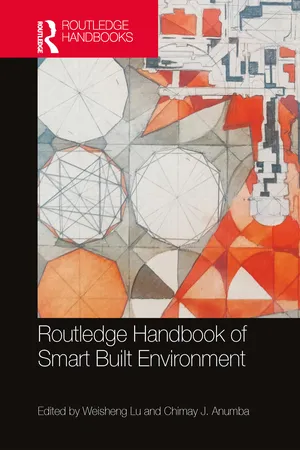
Routledge Handbook of Smart Built Environment
- 316 pages
- English
- ePUB (mobile friendly)
- Available on iOS & Android
Routledge Handbook of Smart Built Environment
About this book
The primary aim of this edited volume is to document the current theories, best practices, and technological advancements in the move towards a Smart Built Environment (SBE). The needs to accelerate towards the SBE are numerous and include:
- Increasing complexities and the need for interconnectivity within the built environment (e.g. mega infrastructure projects)
- Data-driven decision-making resulting in higher demand from clients (e.g. smart design, construction, operation, and end of life [EOL])
- High requirements from stakeholders (e.g. system efficiency, environmental performance, green procurement)
- Fast paced technological advancement and integration
- Natural disaster resilience of the built environment (e.g. prediction, smart control of building component)
- Sustainability issues around the built environment
In this book, the interrelationships among the various lifecycle stages: design, construction, operation, and EOL; the collective benefit of synergy at building level, multi-infrastructure level, and city-level, as well as the ultimate goals in relation to the deployment of smart technologies in the industry are addressed. Part I covers smart design and construction, Part II smart living, and operation, and Part III broadens the scope to the whole smart city. Chapters examine:
- How smart technologies can improve the effectiveness, productivity, and efficiency of the built environment
- An overview of theories and practices that are enabled by innovations and technologies for developing the SBE
- The basis for new research agenda, new concepts, and frameworks for future development
This handbook documents the current theories, practices, and technologies and develops a holistic approach for research and practice by adopting a multidimensional outlook for the SBE. It is an essential reference work for all built environment stakeholders, from academia through to the professions.
Frequently asked questions
- Essential is ideal for learners and professionals who enjoy exploring a wide range of subjects. Access the Essential Library with 800,000+ trusted titles and best-sellers across business, personal growth, and the humanities. Includes unlimited reading time and Standard Read Aloud voice.
- Complete: Perfect for advanced learners and researchers needing full, unrestricted access. Unlock 1.4M+ books across hundreds of subjects, including academic and specialized titles. The Complete Plan also includes advanced features like Premium Read Aloud and Research Assistant.
Please note we cannot support devices running on iOS 13 and Android 7 or earlier. Learn more about using the app.
Information
Table of contents
- Cover
- Half Title
- Title
- Copyright
- Contents
- Foreword
- Introduction
- 1 Digital twins for smart decision-making
- 2 From particles to spaces: The intelligent planning unit (IPU) theory to simplify the built environment
- 3 Generative design for excellence (DfX) for a smart built environment: From rule-based imitation to data-driven exploration
- 4 Project delivery methods to digital fabrication in architecture: A comparative case study from a modularity perspective
- 5 Unlocking the power of language models for smart configuration in the AEC domain using spoken language understanding
- 6 Physical fatigue assessment (PFA) for construction workers with AI and sensory techniques
- 7 Smart or not? Perspectives on digital fabrication and digital construction
- 8 Methodical review of exoskeleton use in the construction industry
- 9 Ontological models for construction scheduling and resource planning
- 10 Iterative digital twin development for high-technology healthcare buildings: The case of a new ophthalmology diagnostic hub
- 11 A theoretical framework for integrating digital twins in building lifecycle management
- 12 Digital twin-based prototype system for healthcare facilities management
- 13 Activity-based models for smart and sustainable urban environment
- 14 Sustainable urban built environment: Principles, tools, and applications
- 15 Exploring the potentials and obstacles of city information modelling
- 16 Mobility-as-a-Service (MaaS) and the built environment
- 17 Integrated smart curb management in urban built environments addressing human dynamics and disruptive technologies
- 18 Digital technologies for climate-adaptive smart urban transportation systems
- 19 Blockchain for smart built environment: Current status, challenges, and prospects
- 20 Effects of signage color on human psychophysiological states and wayfinding performance in urban underground spaces with different noise levels: A combined EEG and VR experiment
- Conclusion
- Index